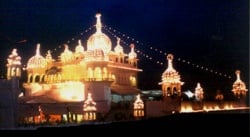Gurpurb
Gurpurb, a compound of two words, i.e. guru, the spiritual preceptor, and purb, parva in Sanskrit, meaning a festival or celebration, signifies in the Sikh tradition the holy day commemorating one or another of the anniversaries related to the lives of the Gurus.
Observance of such anniversaries is a conspicuous feature of the Sikh way of life. A line frequently quoted from the Guru Granth Sahib in this context reads "babania kahania put saput kareni—it only becomes worthy progeny to remember the deeds of the elders" (GG, 951). Among the more important gurpurbs on the Sikh calendar are the birth anniversaries of Guru Nanak and Guru Gobind Singh, the martyrdom days of Guru Arjan and Guru Tegh Bahadur, and of the installation of the Holy Book in the Harimandar at Amritsar on Bhadon sudi 1, 1661 Bk/16 August 1604.
Alongside these may be mentioned Baisakhi, the first day of the Indian month of Baisakh which marks the birth, in 1699, of the Khalsa Panth, and the martyrdom days of the young sons of Guru Gobind Singh. There are indications in the old chronicles that the succeeding Gurus themselves celebrated the birthday of Guru Nanak. Such importance was attached to the anniversaries that dates of the deaths of the first four Gurus were recorded on a leaf in the first recension of the Scripture prepared by the Fifth Guru, Guru Arjan. The word gurpurb had come into use in the times of the Gurus. It occurs in at least five places, in Bhai Gurdas (1551-1636), contemporary with Guru Arjan. To quote, "kurbani tina gursikha bhae bhagati gurpurb karande—I am a sacrifice unto Sikhs who with love and devotion observe the gurpurb" (Varan, XII.2).
What happens on gurpurbs is a mixture of the religious and the festive, the devotional and the spectacular, the personal and the communal. Over the years a standardized pattern has evolved. Yet no special sanctity attaches to the form, and variations can be and are indeed made depending on the imaginativeness and initiative of local groups. At these celebrations, the Sikh Scripture, the Guru Granth Sahib, is read through, in private homes and in the gurdwaras, in a single continuous ceremony lasting forty-eight hours. This reading, called akhand path, must be without interruption; the relay of reciters who take turns at saying the Scripture ensures that no break occurs.
Additionally special assemblies are held in gurdwaras and discourses given on the lives and teachings of the Gurus. Sikhs march in processions through towns and cities chanting the holy hymns. Special langars, or community meals, are held for the participants who at certain places may be counted by the thousand. To partake of a common repast on these occasions is reckoned an act of merit. Programmes include initiating those not already initiated into the order of the Khalsa in the manner in which Guru Gobind Singh had done in 1699. Sikh journals and newspapers bring out their special numbers to mark the event. There are public functions held, besides the more literary and academic ones in schools and colleges. On gurpurbs commemorating birth anniversaries, there might be illuminations in gurdwaras as well as in residential houses. Friends and families exchange greetings. Coming into vogue are the printed cards such as those used in the West for Christmas and the New Year day.
Sikh fervour for gurpurb celebration had an unprecedented outlet at the time of the tercentenary of Guru Gobind Singh’s birth in 1967. There is no evidence on record whether centennials previously had been similarly observed. References are however traceable to a proposal for especially marking the second centennial in 1899 of the birth of the Khalsa. The suggestion came from Max Arthur Macauliffe, author of the monumental work, The Sikh Religion, but it did not receive much popular support. The three-hundredth birth anniversary in 1967 of Guru Gobind Singh turned out to be a major celebration evoking widespread enthusiasm and initiating long-range academic and literary programs.
It also set a new trend and format. With the same ardour have been observed some other days as well; in 1969, the fifth centennial of Guru Nanak’s birth; in 1973, the first centenary of the birth of the Singh Sabha; in 1975, the third centenary of the martyrdom of Guru Tegh Bahadur; in 1977, the fourth centenary of the founding by Guru Ram Das of the city of Amritsar; in 1979, the 500th anniversary of the birth of Guru Amar Das; in 1980, the 200th anniversary of the birth of Maharaja Ranjit Singh; in 1982, the third birth centennial of Baba Deep Singh, the martyr.
External links
Above adapted from article By Harmandar Singh

